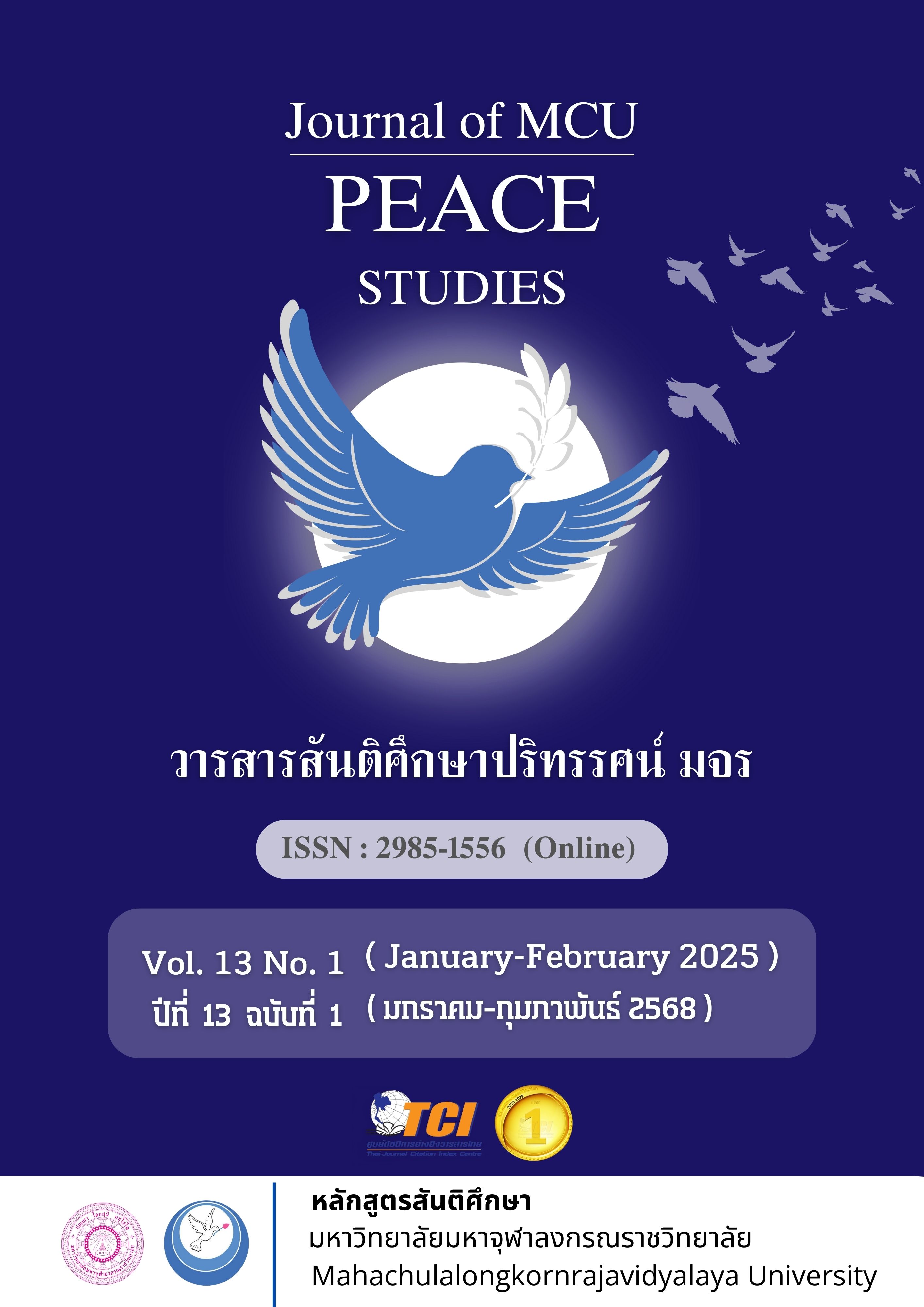อิทธิพลของภาวะผู้นำการเปลี่ยนแปลงและการจัดการเชิงกลยุทธ์ที่มีผลต่อความได้เปรียบทางการแข่งขันผ่านความสามารถเชิงนวัตกรรมของธุรกิจการค้าทองคำ
Main Article Content
บทคัดย่อ
การวิจัยนี้มีวัตถุประสงค์เพื่อศึกษา 1) ระดับภาวะผู้นำการเปลี่ยนแปลง การจัดการเชิงกลยุทธ์ ความสามารถเชิงนวัตกรรม และความได้เปรียบทางการแข่งขัน 2) อิทธิพลทางตรงและทางอ้อมของภาวะผู้นำการเปลี่ยนแปลง การจัดการเชิงกลยุทธ์ ความสามารถเชิงนวัตกรรม และความได้เปรียบทางการแข่งขัน และ 3) อิทธิพลของภาวะผู้นำการเปลี่ยนแปลงและการจัดการเชิงกลยุทธ์ที่มีผลต่อความได้เปรียบทางการแข่งขันผ่านความสามารถเชิงนวัตกรรมของธุรกิจการค้าทองคำ การวิจัยครั้งนี้เป็นการวิจัยแบบผสมผสานระหว่างการวิจัยเชิงปริมาณและเชิงคุณภาพ การวิจัยเชิงปริมาณมีกลุ่มตัวอย่าง คือ ผู้ประกอบการธุรกิจการค้าทองคำ จำนวน 300 ตัวอย่าง กำหนดขนาดของกลุ่มตัวอย่างใช้หลักเกณฑ์ 20 เท่าของตัวแปรสังเกตได้ การสุ่มตัวอย่างแบบเจาะจง ใช้แบบสอบถามในการเก็บรวบรวมข้อมูล วิเคราะห์ข้อมูลด้วยสมการโครงสร้าง สำหรับการวิจัยเชิงคุณภาพ เก็บรวบรวมข้อมูลด้วยการสัมภาษณ์เชิงลึก จากผู้เชี่ยวชาญ จำนวน 9 คน และวิเคราะห์ข้อมูลด้วยการวิเคราะห์เชิงเนื้อหา
ผลการวิจัยพบว่า 1) การภาวะผู้นำการเปลี่ยนแปลง การจัดการเชิงกลยุทธ์ ความสามารถเชิงนวัตกรรม และความได้เปรียบทางการแข่งขันของธุรกิจการค้าทองคำ มีความคิดเห็นอยู่ในระดับมาก 2) ภาวะผู้นำการเปลี่ยนแปลง การจัดการเชิงกลยุทธ์ ผ่านความสามารถเชิงนวัตกรรมมีอิทธิพลทางบวกต่อความได้เปรียบทางการแข่งขันของธุรกิจการค้าทองคำ อย่างมีนัยสำคัญ 3) อิทธิพลของภาวะผู้นำการเปลี่ยนแปลงและการจัดการเชิงกลยุทธ์มีผลต่อความได้เปรียบทางการแข่งขัน ผ่านความสามารถเชิงนวัตกรรมของธุรกิจการค้าทองคำ มีความสอดคล้องกลมกลืนกับข้อมูลเชิงประจักษ์อย่างมีนัยสำคัญ ค่าไคสแควร์ มีค่าเท่ากับ 1.129 แสดงว่ามีความสอดคล้องกับค่าดัชนีอื่น ๆ เช่น GFI, AGFI, CFI, และ RMSEA เป็นสมการโครงสร้างที่มุ่งเน้นให้เกิดความได้เปรียบทางการแข่งขันของธุรกิจการค้าทองคำ
Article Details

This work is licensed under a Creative Commons Attribution-NonCommercial-NoDerivatives 4.0 International License.
ทัศนะและความคิดเห็นที่ปรากฏในบทความในวารสาร ถือเป็นความรับผิดชอบของผู้เขียนบทความนั้น และไม่ถือเป็นทัศนะและความรับผิดชอบของกองบรรณาธิการ ยินยอมว่าบทความเป็นลิขสิทธิ์ของวารสาร
References
Abdullah, N. N., & Othman, M. B. (2019). Examining the Effects of Intellectual Capital on the Performance of Malaysian Food and Beverage Small and Medium-Sized Enterprises. Technology (IJCIET), 10(2), 135-143.
Agustia, D., Muhammad, N. P. A., Permatasari, Y. (2020). Earnings Management, Business Strategy, and Bankruptcy Risk: Evidence from Indonesia. Journal Homepage, 6(2), 1-9.
Al-Ahmad Chaar, S., & Easa, N.F. (2021). Does Transformational Leadership Matter for Innovation in Banks? The Mediating Role of Knowledge Sharing. International Journal of Disruptive Innovation in Government, 1(1), 36-51.
Amit, R., & Zott, C. (2021). Value Creation in E-Business. Strategic Management Journal, 22(6-7), 493-520.
Argyres, N., Bigelow, L., & Nickerson, J. A. (2015). Dominant Designs, Innovation Shocks, and Follower’s Dilemma. Strategic Management Journal, 36(2), 216-234.
Ashoor, W. A. (2021). Transformational Leadership and Innovation for Competitive Advantage in Large Firms and SMEs. International Journal of R&D Innovation Strategy, 3(1), 1-12.
Bel, R. A. (2018). A Property Rights Theory of Competitive Advantage. Strategic Management Journal, 39(2018), 1678-1703.
Chungyas, J., & Trinidad, F. L. (2022). Strategic Management Practices and Business Performance of Cooperatives an Ifugao, Philippines: Basis for Strategic Planning Model. International Journal of Management & Entrepreneurship Research, 4(2), 84-104.
Crabb, A. W. (2012). Sustainable Strategic Management and Market Effectiveness of Enterprises. Procedia-Social and Behavioral Science, 58(2012), 899-905.
Dolmatova, M., Vasin, A., & Gao, H. (2015). Supply Function Auction for Linear Asymmetric Oligopoly: Equilibrium and Convergence. Information Technology and Quantitative Management, Procedia Computer Science, 55(2015), 112-118.
Farida, I., & Setiawan, D. (2022). Business Strategies and Competitive Advantage: The Role of Performance and Innovation. Open Innovation Technology Market and Complexity, 8(163), 1-18.
Feranita, N. V., Nugraha, A., & Sampir, A. S. (2020). Effect of Transformational and Transactional Leadership on SMEs in Indonesia. Problems and Perspectives in Management, 18(3), 415-425.
Giddens, J. (2018). Transformational Leadership: What Every Nursing Dean Should Know. Journal of Professional Nursing, 34(2), 117-121.
Grönlund, S.E. (2019). Indicators and Methods to Assess Sustainability of Wastewater Sludge Management in the Perspective of Two Systems Ecology Models. Ecological Indicators, 100(2019), 45-54.
Hui, L., Phouvong, S., & Phong, L. B. (2018). TL Facilitates Innovation Capability: The Mediating Roles of Interpersonal Trust. International Journal of Business Administration, 9(3), 1-9.
Itafe, M. J., & Itohan, I. (2023). The Effect of Strategic Management Practices on Organizational Competitiveness. EPRA International Journal of Research and Development (IJRD), 8(5), 142-153.
Jiang, Y., & Chen, C. C. (2018). Integrating Knowledge Activities for Team Innovation: Effects of Transformational Leadership. Journal of Management, 44(5), 1819-1847.
Palmi´e, M., Rüegger, S., & Parida, V. (2023). Micro Foundations in the Strategic Management of Technology and Innovation: Definitions, Systematic Literature Review, Integrative Framework, and Research Agenda. Journal of Business Research, 154(6), 1-17.
Prayuda, R. Z., & Purwanto, A. (2024). The Role of Locus of Control, Financial Knowledge and Income on Financial Management Behavior: PLS-SEM Analysis. PROFESOR: Professional Education Studies and Operations Research, 1(02), 1-5.
Ramadan, M., & Borgonovi, E. (2016). Strategic Management Practices as a Key Determinant of Superior Non-Governmental Organizations Performance. Problems of Management in the 21st Century, 11(2), 71-92.
Santoso, I. H., Wanto, H, S., & Siswati, E. (2021). The Influence of Transformational Leadership and Innovation on Organizational and Individual Outcomes: Evidence from Indonesia. International Journal of e-Business and e-Government Studies, 13(2), 17-32.
Vicente, M., Abrantes, J. L., & Teixeira, M. S. (2015). Measuring Innovation Capability in Exporting Firms: the INNOVSCALE. International Marketing Review, 32(1), 29-51.
Vichaidist, B. (2023). Thailand’s Opportunity to Become the World’s Gold Trading Hub. Retrieved May 5, 2024, from https://infocenter.git.or.th/article/article-20230920
Visser, S. W. J., & Scheepers, C. B. (2022). Organizational Justice Mechanisms’ Mediating Leadership Tyle, Cognition- and Affect-Based Trust during COVID-19 in South Africa. Europe Business Review, 34(6), 776-797.
Yangailo, T. (2023). Assessing the Influence of Transformational Leadership on Competitive Advantage through Important Innovations and Quality Results: Case of Railway Industry. Management Science Letters, 13(1), 41-50.
Zakiyah, Yusuf, F. A., & Wildan, U. (2023). The Influence of Operations Strategy, Innovation and It Readiness on Smart City Implementation in Serang City and Its Impact on Public Organization Performance. Kontigensi: Jurnal Ilmiah Manajemen, 11(2), 544-555.
Zawislak, P. A. et al. (2014). The Different Innovation Capabilities of the Firm: Further Remarks upon the Brazilian Experience. Journal of Innovation Economics, 13(1), 129-150.
Zhang, W., Xu, F., & Wang, X. (2020). How Green Transformational Leadership Affects Green Creativity: Creative Process Engagement as Intermediary Bond and Green Innovation Strategy As Boundary Spanner. Sustainability, 12(9), 1-17.
Zhao, T., Song, Z., & Li, T. (2018). Effect of Innovation Capacity, Production Capacity and Vertical Specialization on Innovation Performance in China’s Electronic Manufacturing: Analysis from the Supply and Demand Sides. PLOS One, 13(7), 1-23.

